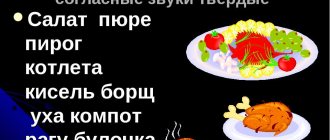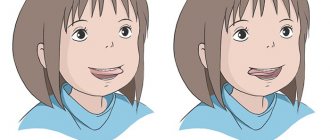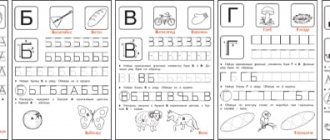How are hissing sounds produced?
You already know that consonant sounds are formed when air passes through various barriers in the oral cavity: lips, teeth, tongue. When overcoming obstacles, noise is produced. Some consonants have a voice added to the noise. Therefore, we distinguish between voiceless consonants (formed only from noise) and voiced consonants (obtained by combining voice and noise). Examples: voiceless consonants are t, f, s, voiced consonants are d, v, z.
Hissing sounds also belong to consonants. They are placed in a separate group due to their educational characteristics.
Let's take a walk through the Magic Forest and get to know the hissing sounds in detail. Many animals and birds live in the huge Magic Forest. Take a look around.
Here in the clearing a hedgehog is trying to catch a dragonfly, and the hedgehogs are playing hide and seek near a tree stump. Nearby, a hare is looking after her little bunnies, and they are cheerfully whispering about something.
In a forest lake, a predatory fish, the pike, has gone hunting, and the spiny fish, the ruffe, is learning to swim long distances.
But an important titmouse bird sat down on a cherry tree branch. She carefully watches the guests of the forest.
Guys, say the words out loud:
- hedgehog, hedgehog, important;
- hare, hares, prickly, bird, titmouse;
- predatory, pike;
- ruff, cherry.
What consonant sound is there in each word in the line numbered 1? (sound [zh]). On the line number 2? (sound [h]). Under the number 3? ([sch]). Under the number 4? ([w]). These sounds: Zh, Ch, Shch, Sh are called hissing consonant sounds.
If you listen closely, you can hear these sounds in our forest. A bumblebee flew by. How does it buzz?
A snake slithered through the grass. She saw the danger and hissed.
The sparrows are noisily discussing something.
The squirrel cracks nuts.
There are many of these sounds in the world around us. Why are they called hissing? Let's listen to what the Wise Owl will explain to us about this.
Hissing sounds are divided into voiced and unvoiced.
The sound [zh] is pronounced with the participation of noise and voice: zh-zh-zh. It is ringing: heat, buzzing, yellow.
And the sounds [ch'], [sh], [sh'] are formed with the participation of only noise, so they are dull: a cup, a hut, a sliver.
The hissing zh–sh form a pair in terms of sonority and deafness: heat-shar, pity-shawl, gesture-six. The sounds h, sch do not have a pair in terms of voiceness.
In terms of softness and hardness, not a single sibilant forms a pair with other consonants. The hissing sounds [zh], [sh] are always hard consonants: beetle [beetle], rustle [shorah].
The sounds of soft consonants in all situations are produced by hissing [ch'], [sch']: hours [ch'asy], brush [sh'otka].
Setting option when there is no sound
If a child does not have Sh in his speech, and he does not use other phonemes instead, then the main emphasis is on articulatory gymnastics, namely the formation of a wide tongue rise. When the “Cup” exercise is performed correctly, the speech therapist begins to produce sound.
He asks the child to make a “Cup” and hide his tongue behind his teeth. Next, the speech therapist explains that you need to blow on your tongue and then you will get Sh. If the child pronounces X, then a clear hissing sound will not be produced. For convenience, they suggest pronouncing C, only the tongue is behind the upper teeth. To develop the correct pronunciation, you need to repeat it many times. To increase the effectiveness of classes, the speech therapist uses didactic games.
Spelling sibilants in combination with vowels and consonants
Guys, to be literate, you need to know the rules for writing letters in different words. Today we will learn the spelling of sibilants with vowels, find out how the combinations chk, chn, cht, schn are written.
Rules for writing cha-sha, chu-shu, zhi-shi
Hissing sounds are not friendly with all vowels. Listen to the story from the Wise Owl about why this happened.
“How the hissing ones stopped being friends with Y, Yu, Ya”
Once upon a time, the hissing Zh, Sh, Ch, Shch, together with the vowels A, I, Y, U, Yu, Ya, decided to go into the forest to pick mushrooms. The sun was shining brightly, the trees rustled their leaves welcomingly. Mushrooms sat under almost every leaf and blade of grass. And then the berries themselves ask to be added to the basket.
The hissing ones didn’t notice that they went in a completely different direction and got lost. They look around: the places are unfamiliar, and there are no vowels nearby. They tried to scream and call for help. It's all to no avail. Zh's voice is weak, while Sh, Ch, Shch have only noise and hissing. It's already getting colder, it will start getting dark in an hour. What to do?
And suddenly they see: there are notches on the tree trunks. Someone cut out the letters: A, I, U, as if showing the way. And the hissing ones walked along the path along which there were notches in the trees. Soon they heard the sounds of “Ay! Ay!”, a drawn-out song “E-i-i-i!” and ran towards the screams. Finally, they came out to a familiar clearing. And there the vowels are already waiting for them: I, A, U. How the sounds rejoiced at each other!
But then the hissers noticed that Yu, Y, Ya were missing among the vowels. It turns out they refused to look for the hissers, because they thought that they themselves were to blame for everything. They wanted to rest, and they went home.
The hissing consonant sounds were so upset that since then they have not been friends with Yu, Y, Ya, who abandoned them in trouble, but only go with A, I, U.
What is this fairy tale about, guys? That friends should not be left in trouble, you need to help them or call adults.
Here's a rule you need to remember:
Let's practice correctly identifying a vowel after a sibilant, and complete the task of the Wise Owl.
Exercise “Find the word”
Match the pictures with the corresponding words and fill in the missing letters in the words.
Answer: cone, shield, teapot, lampshade, toad, hat, key.
Spelling of hissing ch in combinations: chk, chn, cht, nch, schn, nsch
Guys, read the words in the columns.
horse benefit donut
laziness mill twig
stump blizzard mail
steering wheel fight racer
mole skates predator
How is the softness of consonant sounds in words in the first column indicated? Answer: using the sound [e] and ь. How is the softness of the consonants indicated in the second column? Answer: vowel sounds [e], [i], b.
Look at how the softness of the consonants is indicated in the third column. Answer: only with vowel sounds [e]. Tell me, does the vowel [i] in the words donut, racer affect the softening of the sounds [ch'], [sch']? Why? Answer: because they are unpaired soft consonants.
Now pay attention to how softly the combinations nch, chk, cht, nsch, schn are pronounced in the words of the third column. Is there a soft sign between these combinations? No. Why do you think? Is it needed? Answer: no, it’s not necessary, because the sounds ch, sch are always soft.
Soft sibilants influence and soften other consonant sounds that come after them. In the word drummer we hear soft n [n'], although there is neither a softening vowel nor b nearby. The same thing happens in the words: chick, suitcase, ice cream man.
Let's write down the transcriptions of these words:
- drummer – [drum'sh'ik]
- chick – [pt'en'ch'ik]
- suitcase – [ch'imadan'ch'ik]
- ice cream maker – [marozhyn'sch'ik]
Softness in the combinations nch, chk, cht, nsch, schn is indicated in transcription for two sounds [n] and [ch'].
Setting Sh with distorted pronunciation
The method of presentation depends on the type of sigmatism. Each of them has its own reasons, so the speech therapist selects techniques to correct them:
- With the interdental variant, exactly the same preparatory work is carried out as in the absence of a phoneme in speech. The emphasis is on raising the tongue, so they additionally practice clear pronunciation of T, from which the sound will be made. When pronouncing T, the child keeps his mouth open. You need to pronounce the sound slowly, adding aspiration. Gradually, the speech therapist teaches the child to lengthen the air stream and not touch the tubercles with the tongue.
- For lateral distortion, a mechanical method is used. Before insertion, the lateral edges of the tongue are strengthened; They teach you to raise and hold your tongue behind your teeth, and form a strong, long, directed exhalation. For placement, you can use a special speech therapy probe or a teaspoon (if you are doing correction at home). Using a probe or spoon, the front part of the tongue is lifted and removed behind the upper teeth, moving it closer to the tubercles. The child bites the spoon and pronounces S. Gradually, the duration of exhalation increases, and the ability to lift and hold the tongue in the desired position independently is formed.
- The method of setting from P - this method is rarely used, because to pronounce a sonorant group the tongue occupies a similar position as for sibilants. Therefore, few children can speak R correctly if they have problems with the pronunciation of sibilants. The child, keeping his mouth open, pronounces R silently. An adult, using the handle of a teaspoon, stops the vibration. The result is hissing. Gradually, the spoon is used less, the child learns to keep his teeth together and make a hissing sound without mechanical assistance.
- Method of setting from whistlers. The child pronounces an elongated S, the adult places a teaspoon or probe under the front edge of the tongue, lifts it and moves it deeper into the mouth until he hears Sh in speech. Gradually, the child learns to independently lift and cup his tongue.
If there are disturbances in the tone of the tongue muscles, a course of speech therapy massage is prescribed. It is performed using probes (for this you need to undergo special training) or fingers wearing sterile disposable gloves. But along with the massage you need to do articulation gymnastics. Then the preparation of the organs of articulation for the production of Ш will be more effective.
The sound Ш is the main one in its group. Therefore, having corrected its pronunciation, it is easy to add other sibilants. You just need to explain the difference in articulation so that the child does not mix them up in speech. You need to start producing other hissing sounds when you have passed the stage of automating the sound Ш in speech.
Reasons for violation
This deviation in speech is called sigmatism. Medicine has identified a number of reasons why a child cannot pronounce the sound Sh.
appears if the sound is not solid, but clapping. The reason for this is an open lateral bite. Also if in children
Lateral sigmatism
present
dysarthria
, the muscles of the tongue are poorly developed.- Interdental sigmatism is caused by a too short frenulum located under the tongue. Therefore, the tongue cannot reach the palate. This form of deviation forms a lisp.
- With nasal sigmatism, tension occurs in the tongue muscle in the back of the tongue.
- Labial-dental parasigmatism occurs when a child has an incorrect bite. The cause may also be a problem with phonemic hearing.
- When dental parasigmatism replaces
the sound “sh”
in words a voiceless
“t”. Occurs when language tone decreases. - Whistling and hissing parasigmatism is caused by the replacement of the hard “w” with “s” and “z”.
An important factor is also the manner of communication between parents and the baby. Often adults deliberately imitate a child, considering this pronunciation funny. However, the baby thinks that this is what he should say, so over time he gets used to the incorrect pronunciation.
Doctors and specialists specifically focus on this point and recommend that parents talk to their child correctly.
With poor articulation
there is a decrease in the quality of pronunciation of sounds.
Also, with a short frenulum,
problems arise with the sucking reflex.






